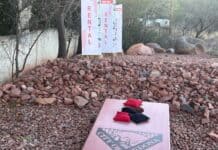In the early days of Hollywood, Sedona played host to nearly 100 movies — most of which were Westerns that showcased what has made this area popular.
Today, Sedona is featured in the occasional commercial, music video and even a movie or two. But it’s that history of Sedona movie-making from the 1940s through the 1960s that has some wishing to see it be more prominently promoted.
One of those who would like to see a film museum in Sedona is Graham Hill, a California resident who has been a film historian for the past 40 years. He and his wife have been traveling the country, meeting with leaders in communities in which Hollywood filmmaking has deep roots.
On Thursday, May 31, Hill met with Sedona Arts and Culture Coordinator Nancy Lattanzi. A video montage that Hill put together featuring some of the area’s most recognizable rock formations in numerous classic Westerns will be shown during the moment of art segment to start the Tuesday, June 12, Sedona City Council meeting at 4:30 p.m.
Lattanzi said it’s fortunate Sedona Heritage Museum found and then restored the Telegraph Office from John Wayne’s “Angel and the Badman,” which is the last remaining structure used in the old films. There, guests can read about and view clips of old movies.
“I’ve always felt our community would benefit by having a film museum that could preserve the almost 100 Hollywood productions filmed here,” Lattanzi said. “To have a space designated to bring the past to life while educating the public with stories of our film history, displaying old movie posters and collectibles and ultimately running old films on a regular schedule for the public to enjoy, would be a true gift for our community and Sedona’s film legacy.”
Some of the biggest names in Hollywood starred in movies in which Sedona was featured, including John Wayne, Jimmy Stewart, Joan Crawford, Henry Fonda, Steve McQueen and Elvis Presley. Scenes filmed here appeared in Westerns with the area substituting for other locations such as New Mexico, Nevada, California, Utah, Oregon and Canada.
But as time went on, fewer movies in this genre were made and even fewer in Sedona.
“Monument Valley is a bit bleak — you have the mesas and the buttes,” Hill said. “Sedona’s got the beauty and was easier to film here. There was a lot of diversity here — you have the mountains but also the greenery, Oak Creek and the vast panoramas. Monument Valley has them, too, but nothing like here.”
But just as fast as Sedona became one of the hot spots of movie-making, in time the studios stopped coming.
“As time went on, the pristine views began to disappear,” Hill said in reference to homes and businesses being built. “Back then you didn’t have CGI [computer-generated imagery] where you could block something out in a scene. Plus, it was getting more expensive to film on location because of the logistics in getting here.”
It wasn’t just the studios that stopped coming to Sedona to make Westerns. The interests of moviegoers began to change in the late 1960s and beyond as fewer cowboy movies were being made.
“Everybody’s perception of the Old West is what they see in the movies,” Hill said. “It’s people outside of America who have always appreciated Western movies. Europeans idolized America. After World War II, America was like superheroes to the world. Cowboy movies were basically good propaganda for America. The good guy always wins.”
Hill mentioned director Delmer Daves, who was often in the shadow of director John Ford but made classic Westerns such as “3:10 to Yuma,” “The Last Wagon,” “Drum Beat” and “Broken Arrow” — all of which were filmed in Sedona. He said because of directors like Daves, movies have kept Sedona’s history in a time capsule.
Adding to that capsule are authors like Joe McNeil, who penned the book “Arizona’s Little Hollywood.” Hill praised McNeil’s work in detailing Sedona’s history with Hollywood while also dispelling myths that have lingered for years.
“I already knew a lot of what he had in his book, but I also learned quite a bit,” Hill said.
In terms of preserving Sedona’s movie making past, Hill said he would hope that an organization or individual would step forward and build a museum dedicated to this topic. He said he would encourage any of the many tour companies to tap into an older market and offer tours that would take guests to spots made famous in movies from a time gone by.
“The baby boomers are the ones who have the time and the money, and I feel they would love to see movie locations,” Hill said. “They saw these movies as a kid. But when you bring back those images through photographs or a movie itself, you can take them to these specific locations where the movies were filmed and allow them to recall the days of their youth.”
Ron Eland can be reached at 282-7795 ext. 122, or email reland@larsonnewspapers.com


















